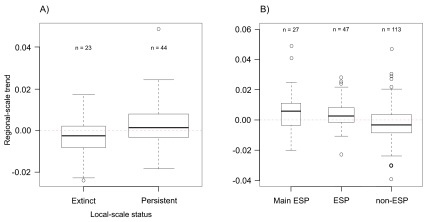Abstract
Despite the widespread concern about the fate of pollinators and the ecosystem services they deliver, we still have surprisingly scarce scientific data on the magnitude of pollinator declines and its actual contribution to crop pollination and food security. We use recently published data from northeastern North America to show that studies at both the local and regional scales are needed to understand pollinator declines, and that species-specific responses to global change are broadly consistent across scales. Second, we show that bee species that are currently delivering most of the ecosystem services (i.e. crop pollination) are not among the species showing declining trends, but rather appear to thrive in human-dominated landscapes.
Main text
There is widespread concern regarding the fate of pollinators and the ecosystem services they deliver 1. However, the information we have is still limited and at times appears contradictory. Four recent articles, three from Science and one from PNAS, highlight this point 2– 5. Burkle et al. 2 show that 50% of the bee species in one locality in the Midwestern USA became locally extinct during the last century, which in combination with recent evidence that wild pollinators are critical to global crop pollination 3, has led some to conclude that we might face an imminent collapse of crop pollination 4. In contrast, Bartomeus et al. 5 explored bee declines over a similar time scale but at a regional scale (the northeastern USA) and reported only a 15%, non-significant decline in bee species richness. Here we present new analyses that help to reconcile this apparent contradiction in the magnitude of bee declines, while also suggesting that any effects on crop pollination might be less than previously thought.
First, we used the 67 bee species included in both the regional-scale 5 and the local-scale 2 analyses (see data file below) to show that the two studies in fact found broadly consistent results: the locally extinct species of Burkle 2 tend to be declining regionally, whereas the locally persistent species tend to be increasing regionally ( Figure 1A, ANOVA: F = 5.89, df = 1,65, P = 0.01). Second, we used data from Garibaldi et al. 3 on the bee species that provide ecosystem services to four crops in the region covered by Bartomeus et al. 5 to show that these ecosystem service providers tend to have increasing population trends compared to non-ecosystem service providers ( Figure 1B, F = 7.12, df = 2,184, P = 0.001). All analyses were conducted in R 6.
Figure 1. Trend in bee species' relative abundance in northeastern North American calculated over the period 1870–2011.

A) For species that either became locally extinct or persisted in Carleville, Illinois. B) For species that either are not ecosystem-service providers to crops (non-ESP), are at least occasionally ecosystem-service providers to crops (ESP), or are among the species cumulatively responsible for 90% of the pollinator visitation to at least one crop (main ESP). Regional data from Bartomeus et al. 5, local data from Burkle et al. 2 and crop pollinator data from Garibaldi et al. 3.
Regional-scale trend from Bartomeus et al. (2013) in relative abundance calculated over the period 1870-2011. Local-scale status from Burkle et al. (2013) shows extinction or persistence in Carleville, Illinois. Ecosystem Service Provider is classified in non-ESP (not ecosystem-service providers to the studied crops), ESP (occasionally ecosystem-service providers to the studied crops), and main ESP (among the species cumulatively responsible for 90% of the pollinator visitation to at least one of the studied crop) according to data from Garibaldi et al. (2013). See main article for references.
Thus, our analyses demonstrate that, as one would expect, local-scale extinctions do not imply regional-scale extinctions; and that bee species that are important crop pollinators are less likely to be declining at the regional scale. It is important to remember that all bee species may well be crucial to providing ecosystem functions in natural systems and therefore merit conservation attention.
Funding Statement
This work was supported by United States Department of Agriculture NIFA-AFRI 2009-65104-05782 to R Winfree and N M Williams, Multi-state project 08204 to R Winfree and NSF BIO DEB collaborative grant #0554790/0516205 to C Kremen, N M Williams, and R. Winfree.
The funders had no role in study design, data collection and analysis, decision to publish, or preparation of the manuscript.
v1; ref status: indexed
References
- 1.Potts SG, Biesmeijer JC, Kremen C, et al. : Global pollinator declines: Trends, impacts and drivers. Trends Ecol Evol. 2010;25(6):345–353 10.1016/j.tree.2010.01.007 [DOI] [PubMed] [Google Scholar]
- 2.Burkle LA, Marlin JC, Knight TM: Plant-pollinator interactions over 120 years: loss of species, co-occurrence, and function. Science. 2013;339(6127):1611–1615 10.1126/science.1232728 [DOI] [PubMed] [Google Scholar]
- 3.Garibaldi LA, Steffan-Dewenter I, Winfree R, et al. : Wild pollinators enhance fruit set of crops regardless of honey bee abundance. Science. 2013;339(6127):1608–1611 10.1126/science.1230200 [DOI] [PubMed] [Google Scholar]
- 4.Tylianakis JM: Ecology. The global plight of pollinators. Science. 2013;339(6127):1532–1533 10.1126/science.1235464 [DOI] [PubMed] [Google Scholar]
- 5.Bartomeus I, Ascher JS, Gibbs J, et al. : Historical changes in northeastern US bee pollinators related to shared ecological traits. Proc Natl Acad Sci U S A. 2013;110(12):4656–4660 10.1073/pnas.1218503110 [DOI] [PMC free article] [PubMed] [Google Scholar]
- 6.R Development Core Team. R: A language and environment for statistical computing. R Foundation for Statistical Computing, Vienna, Austria. ISBN 3-900051-07-0, URL2008. Reference Source [Google Scholar]


